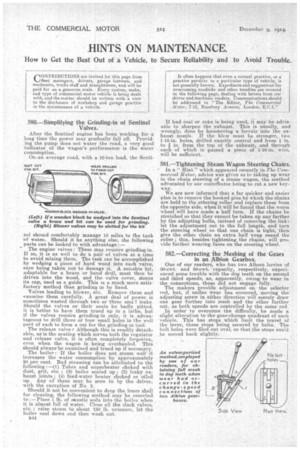.HINTS ON MAINTENANCE.
Page 28

If you've noticed an error in this article please click here to report it so we can fix it.
How to Get the Best Out of a Vehicle, to Secure Reliability and to Avoid Trouble.
580.—Simplifying the Grinding-in of Sentinel Valves.
After the Sentinel engine has been working for a long time the power may gradually fall off. Providing the pump does not water the road, a very good indicator of the wagon's performance is the water consumption.
On an average road, with a 10-ton load, the Senti
nel should comfortably manage 18 miles to the tank of water. Should it be anything else, the following parts can he looked to with advantage :— " The engine valves These may require grinding-in. if so, it is as well to do a pair of valves at a time to avoid mixing them. The task can be accomplished by wedging a piece of hard wood into each valve, care being taken not to damage it. A suitable bit, adaptable for a brace or hand drill, must then be driven into the wood, and the valve cover, Minus its cap, used as a guide. This is a much more satisfactory method than grinding in by hand.
Valves leading to blower, etc. Remove these and examine them carefully. A great deal of power is sometimes wasted through two or three smarl leaks. Should the valves or their seats be badly pitted, it is better to have them trued up in a lathe, but if the valves require grinding-in only, it is advantageous to drill three or four small holes in the well part of each to form a cut for the grinding-in tool. , The release valve rAlthough this is readily detachable, as is the seating which serves both the regulator and release valve, it is often completely forgotten, even when the wagon is being overhauled. This should always-be examined and trued up if necessary.
The boiler : If the boiler does not steam well it increases the water consumption by approximately 20 per cent. Bad steaming can be attributed to the following :--(1) Tubes and superheater choked with dust, grit, etc. ; (2) boiler scaled up ; (3) leaky exhaust joints; • (4) feed-water heater choked or oiled up. Any of these may be seen to by the driver, with the exception of No 2. Should it not be convenient to drop the inner shell for cleaning, the following method may be resorted to : —Place lb. of oaustic soda into the boiler when it is almost full of water. Close all the clack valves, etc. ; raise steam to about 130 lb. pressure, let the boiler cool down and then wash out.
1344 If bad coal or coke is being used, it may be advisable to sharpen the exhaust. This is usually, and wrongly, done by hammering a ferrule into the exhaust nozzle. If the blow must be stronger, two 1-16-in, holes, drilled exactly central and from in. to -a in. from the top of the exhaust, and through each of which is passed a piece of 1-16-in, wire, will be sufficient.
581.—Tightening Steam Wagon Steering Chains.
In a-" Hint, which appeared recently in The Commercial Motor, advice was given as to taking up wear in the chain steering of a steam wagon, the method advocated by our contributor being to cut a new keyway. We are now informed that a far quicker and easier plan is to remove the hooked pins by which the chains are held to the steering roller and replace these from the oppesite side, when it will be found that the worm wheel will have made a half turn. If the chains be stretched so that they cannot be taken up any farther by the adjusting bolts' instead of removing the link let the adjustment out to the full length, and turn the steering wheel so that one chain is tight, then give the other chain an extra half wrap round the roller ; this, besides tightening the chains, will provide further wearing faces on the steering wheel.
582.—Correcting the Meshing of the Gears in an Albion Gearbox.
One of our readers, who has two Albion lorries of 30-cwt. and 50-cwt. capa,city, respectively, experienced some trouble with the dog teeth on the second and third speeds; as, apparently, owing to wear in the connections, these did not engage fully.
The makers provide adjustment on the selector rod, but, if undue wear has occurred, moving the adjusting screw in either direction will merely draw one gear further into mesh and the other further out, as both speeds are controlled by the same rod. In order to overcome the difficulty, he made a slight alteration to the gear-change quadrant of each vehicle. This has stops which limit the travel of the lever, these stops being secured by bolts. The bolt holes were filed out oval, so that the stops could be moved back slightly.






























